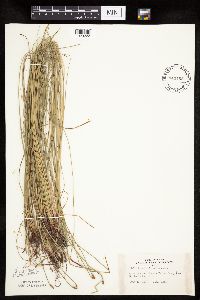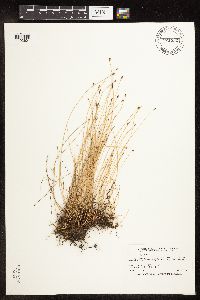Eleocharis erythropoda
|
|
|
|
Family: Cyperaceae
Bald Spike-Rush, more...spikesedge
[Eleocharis calva Torr., moreScirpus glaucus Torr., Trichophorum palustre var. calvum (Torr.) House, Trichophyllum palustre var. calvum (A. Gray) House] |
Plants perennial, mat-forming; rhizomes evident, long, 0.5-1.5 mm thick, soft to firm, cortex often breaking loose, longer internodes 5-30 mm, scales often fugaceous, 4-8 mm, membranous, not fibrous. Culms terete, often with 8-12 blunt ridges when dry, 8-80 cm × 0.3-1.4 mm, firm to soft, internally spongy. Leaves: distal leaf sheaths persistent, not splitting, proximally red (to stramineous), distally green to stramineous, usually inflated, often callose, membranous to papery, apex often red-brown, broadly obtuse to subacute, tooth sometimes present, to 0.1 mm. Spikelets ovoid to lanceoloid or nearly cylindric, 3-18 × 2-3(-4) mm, apex acute (to obtuse); proximal scale amplexicaulous, entire; subproximal scale with flower; floral scales often spreading in fruit, 15-50, 4-5 per mm of rachilla, medium brown to sometimes red-brown, midrib regions mostly stramineous to green, in proximal part of spikelet ovate, apex rounded, in distal part lanceolate, apex entire, acute, 2-3.5 × 1.5-1.7 mm, mostly carinate. Flowers: perianth bristles 4 or absent, light brown to stramineous, stout, usually equal, equaling achene to slightly exceeding tubercle; stamens 3; anthers dark yellow to stramineous, 1-1.8 mm, apiculate; styles 2-fid. Achenes not persistent, dark yellow, stramineous, or dark brown, obovoid to obpyriform, biconvex, angles obscure, 0.9-1.6 × 0.7-1.2 mm, apex rounded, neck absent to long, smooth at 30X, or sometimes finely rugulose at 10-30X with 20 or more horizontal ridges in a vertical series. Tubercles brown to whitish, pyramidal, much higher than wide to, lower than wide, 0.35-0.65 × 0.2-0.6 mm. 2n = 16, 18, 19, 20. Fruiting summer. Non-calcareous or calcareous fresh or brackish shores, marshes, meadows, fens, disturbed places; 0-2300 m; Alta., B.C., Man., N.B., N.W.T., Ont., Que., Sask.; Alaska, Ariz., Ark., Colo., Conn., Del., Idaho, Ill., Ind., Iowa, Kans., Ky., Maine, Mass., Mich., Minn., Miss., Mo., Mont., Nebr., N.H., N.J., N.Mex., N.Y., N.C., N.Dak., Ohio, Okla., Oreg., Pa., R.I., S.Dak., Tenn., Tex., Utah, Vt., Va., Wash., W.Va., Wis., Wyo. Eleocharis erythropoda is extremely variable. Intermediates with E. palustris variant b are common in the region of sympatry in the East, and with E. macrostachya variant b in the West, and E. erythropoda is sometimes difficult to distinguish from E. uniglumis. Eleocharis calva Torrey is an invalid name.
Perennial herb with long slender rhizomes, mat-forming 8 cm - 0.8 m tall Leaves: reduced to bladeless sheaths, basal, two per culm, margins fused and enclosing culm, not splitting, reddish basally, green to straw-colored upwards with a reddish brown apex, inflated, papery to membranous, with a blunt to nearly pointed apex that sometimes bears a tiny tooth. Flowers: minute, spirally arranged on the axis of the spikelet, lacking sepals and petals, with zero or four bristles, subtended by a scale. Bristles (when present) straw-colored to pale brown, often unequal, equal to or slightly longer than achene, stout. Stamens three, exserted. Anthers straw-colored to yellow, to 1.8 mm long. Pistil one. Style two-cleft. Fruit: a one-seeded achene, straw-colored, yellow, or brown, about 1 - 1.5 mm long and 0.5 - 1 mm wide, reverse egg-shaped to reverse pear-shaped with a rounded apex, biconvex, smooth (at 30X) or finely wrinkled (at 10-30X). Tubercle brown to whitish, tiny, pyramidal. Seed with a thin, non-adherent wall. Culm: unbranched, 8 cm - 0.8 m long, to about 1.5 mm wide, circular in cross-section, often bluntly eight- to twelve-ridged (when dry), spongy inside, enclosed basally by two fused sheaths. Spikelets: solitary, 3 - 18 mm long, 2 - 3 mm wide, egg-shaped to nearly cylindrical with a pointed apex, with 15 to 50 floral scales. Scales spirally arranged and overlapping, brown with a straw-colored to green midrib, 2 - 3.5 mm long, about 1.5 mm wide, egg-shaped with a rounded apex (lower) to lance-shaped with a pointed apex (upper), keeled. Similar species: No information at this time. Flowering: mid-May to mid-June Habitat and ecology: Common in moist calcareous habitats such as marshes, ditches, and around lakes. Occurence in the Chicago region: native Etymology: Eleocharis comes from the Greek words heleios, meaning "dwelling in a marsh," and charis, meaning grace. Erythropoda means "red stem." Author: The Morton Arboretum FNA 2002 Common Name: bald spikerush Duration: Perennial Nativity: Native Lifeform: Graminoid General: Perennial mat forming with long rhizomes, 0.5-1.5 mm thick, with a cortex that breaks loose, internodes 5-30 mm, ephemeral scales 4-8 mm, membranous, not fibrous; terete stems 8-80 cm long, 0.5-1.5 mm thick. Vegetative: Leaves with upper sheaths persistent, not splitting, red to stramineous below, green to stramineous above, usually inflated, membranous to papery, broadly obtuse, tooth sometimes present. Inflorescence: Ovoid to lanceoloid or cylindric spikelets 3-18 mm by 2-3 mm, acute apex, lower scale stem clasping, entire, floral scales often spreading in fruit, 15-50, with 4-5 per mm on rachilla, brown to reddish brown; in lower part of spikelet ovate, rounded apex, in upper lanceolate, entire apex, acute, 2-3.5 mm by 1.5-2 mm; flowers with perianth bristles 4, light brown to stramineous, stout, equaling achene to slightly exceeding tubercle; achene not persistent, dark yellow, stramineous to dark brown, obovoid to obpyriform. Ecology: Found on shores, along marshes and meadows and disturbed areas from sea level to 7,500 ft (2286 m); flowers in summer. Notes: This is a very variable species, so a collection seems inevitable to establish identity. Especially as you-ll need a scope to figure out the scales. This species is generally rare, not likely. Only found in Arivaca cienega in the vicinity of Sonoran Desert parks. Ethnobotany: Unknown Etymology: Eleocharis is from Greek heleos or helos, a marsh, low ground, meadow and charis, grace, beauty, hence marsh grace, while erythropoda comes from Greek erythros for reddish, and poda for foot, or red footed. Synonyms: Eleocharis calva, Scirpus glaucus, Trichophorum palustre Editor: SBuckley, 2010 From Flora of Indiana (1940) by Charles C. Deam In muddy, sandy or peaty soil in ditches, sloughs, and marshes and on the borders of streams and lakes. In wet, stony or gravelly places along the Ohio River and in springy, marl borders of some lakes. ...... Indiana Coefficient of Conservatism: C = 2 Wetland Indicator Status: OBL |
































































































